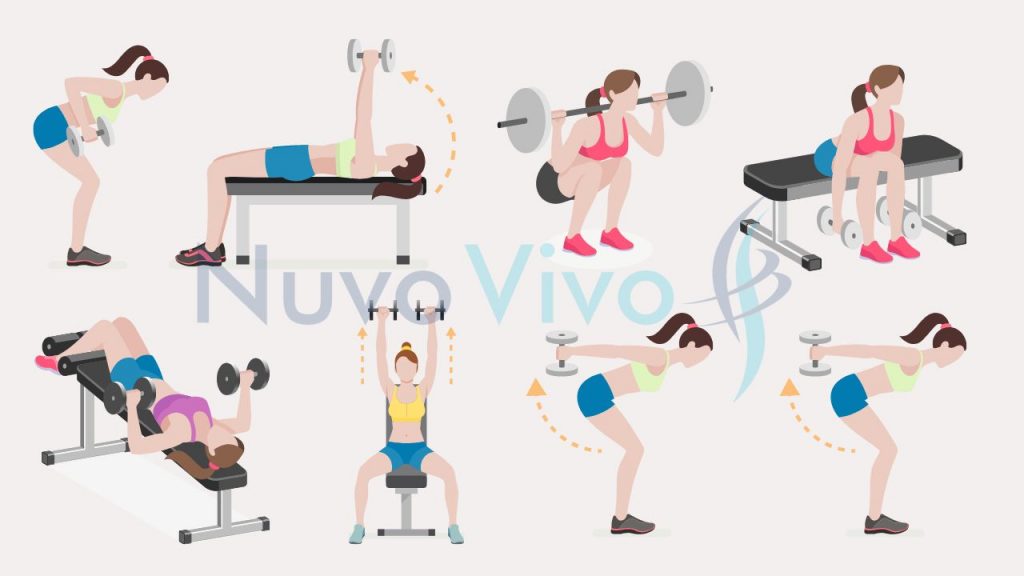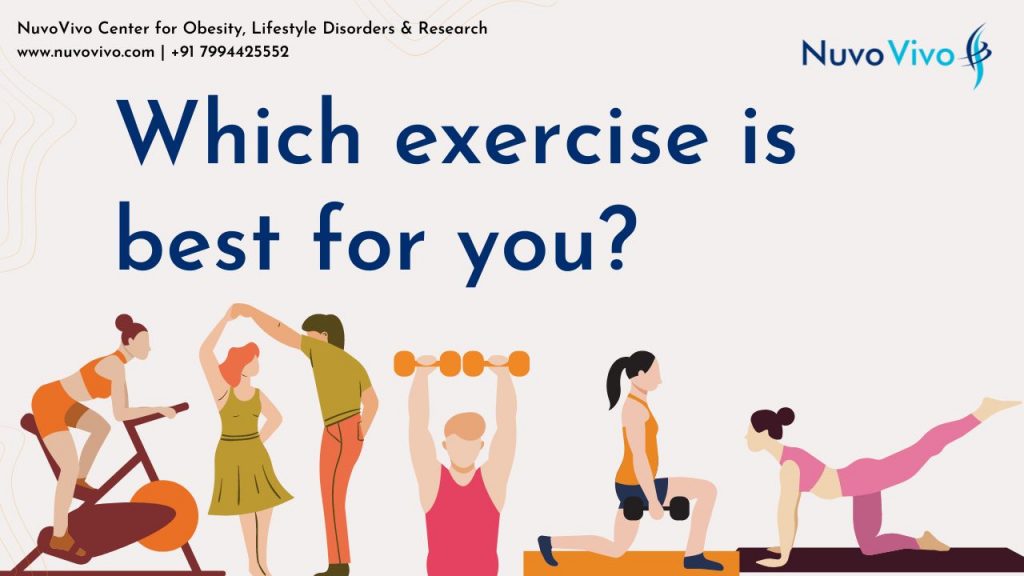Which exercise is best for you? That really depends on a few factors such as – age, your current physical condition and your goal. It also depends on what you like or enjoys the most! Some people enjoy aerobic exercises more, whereas a few others like anaerobic exercises such as weight lifting. A few others are into yoga and flexibility.
One of the most important aspects that are overlooked before starting exercises is the current physical conditions and ailments. They have a huge bearing on the kind of exercises that you should really be doing. Let’s discuss in detail, the different kind of exercises and what it does to the body. We will also delve into the benefits and the precautionary measures to make before performing them.
Exercises can broadly be classified into – Aerobic Exercises & Anaerobic Exercises. Almost all sorts of exercises that we do will fit into this category.
What is Aerobic Exercise?
Aerobic exercise increases your heart rate and breathing for an extended period of time. Examples of aerobic exercise include running, cycling, swimming, and brisk walking.
When you engage in aerobic exercise, your body responds by increasing your heart and breathing rates. This is because your muscles need more oxygen to help them work harder, so your body sends more oxygen-rich blood to your muscles. You would be required to maintain an increased and steady state of oxygen supply to the muscles and tissues. This increased blood flow also helps to remove waste products, such as carbon dioxide and lactic acid, from your muscles.
Also Read: Heart rate while exercising
As you continue to engage in aerobic exercise, your body will adapt to the increased demands placed on it by becoming more efficient at delivering oxygen to your muscles and removing waste products. This can lead to improvements in endurance and overall fitness.
Aerobic exercise can help to improve cardiovascular health by strengthening your heart and blood vessels, and it can also help to lower your risk of chronic diseases such as obesity, diabetes, and heart disease.

Benefits of Aerobic Exercise
Aerobic exercise strengthens the heart and blood vessels, which can help to lower blood pressure and improve overall cardiovascular health. It also improves the body’s efficiency in using oxygen, which can lead to improvements in endurance and overall fitness. Like any type of exercise, aerobic exercises also help in weight management, reduce the risk of lifestyle diseases, and improve overall mood and overall health & wellness.
Also Read: Exercise & Happy Hormones
What is Anaerobic Exercise?
Anaerobic exercise is usually a high-intensity physical activity that lasts for a short period of time and primarily uses the body’s stored energy sources. A few examples of anaerobic exercises are weight lifting, and high-intensity interval training (HIIT).
When you engage in anaerobic exercise, your body responds by quickly using up the stored energy in your muscles, known as glycogen, to fuel your movements. Because anaerobic exercise is intense and requires a lot of energy, it causes your body to produce lactic acid. Lactic acid causes the burning sensation you might feel in your muscles when you exercise at high intensity.

Benefits of Anaerobic Exercise
During anaerobic exercise, your body does not have time to bring in enough oxygen to meet the energy demands of the muscles, thus it relies on the stored energy. As a result, anaerobic exercise does not improve cardiovascular fitness as much as aerobic exercise. However, it can build muscle, increase strength, and improve power and speed.
Interestingly, weight training exercises can even improve bone mineral density and lower the risk of osteoporosis. Weight training exercises also have a direct impact on improving metabolic parameters, more than cardiovascular exercises, as it improves muscle quality and quantity, thereby improving insulin sensitivity. Such exercises are hence particularly helpful in managing diabetes and PCOS
Difference between Aerobic and Anaerobic Exercise
Anaerobic exercise differs from aerobic exercise in that it is typically shorter in duration, higher in intensity, and relies primarily on the body’s stored energy sources. Aerobic exercise, on the other hand, is typically longer in duration, lower in intensity, and relies on the body’s ability to bring in and use oxygen to create energy.
It’s important to note that both types of exercises have different benefits, and incorporating both types of exercises into your fitness routine can help to improve overall health and fitness.
Walking is NOT an exercise
Don’t get me wrong; I’m not saying walking is bad. It is definitely better than being a couch potato. However, walking is an activity, NOT an exercise. It does much less towards improving the body composition and thus the metabolic parameters.
How many calories do you burn in brisk walking? Learn more about it here
Should you avoid any exercise if there is any health condition?
Yes! the answer is a vehement yes! Exercises is one of the best anti-inflammatory activity one could do. However, it needs to be done by also considering the physical conditions and medical conditions, if any. For example – cardio exercises such as running, and cycling are good for the heart. But that does not mean that a person with heart conditions such as congenital heart diseases, tachycardia etc should go running, in anticipation of improving heart health!
Also Read: Health Health & Exercises
High-intensity cardio exercises should be avoided by those with known heart issues such as atherosclerosis (block in the artery), other structural heart issues (value stenosis/regurgitation, reduced Ejection Fraction, regional wall motion abnormalities etc), and other conditions like Supraventricular tachycardia, Ventricular tachycardia etc. Cardio exercises which involve running and jumping are also best avoided if you are overweight by more than 15-20 kgs or have knee pain related to arthritis (Osteoarthritis/Rheumatoid arthritis) and ligament tears as it can exacerbate the issue. If there is a known case of disc bulge, prolapse or herniation, cardio exercises are best approached with caution and with a moderate intensity only. DO NOT perform crunches or sit-ups if there is lower back pain or disc bulge.
Anaerobic exercises such as weight training should be approached with caution in certain conditions such as hernia, and piles. Exercises, especially those involving a lot of core muscles such as weighted squats and deadlifts should be avoided or be performed with low to moderate intensity only.
Exercises involving squatting and lunging are best avoided for those with knee pain or who are overweight by more than 20 kgs, from their ideal weight
Which exercise burns more calories?
The number of calories burned during exercise depends on several factors, including the type of exercise, the intensity of the exercise, and the individual’s weight and level of fitness. In general, exercises that are more intense and that involve larger muscle groups will burn more calories than exercises that are less intense and that involve smaller muscle groups.
Most of the cardio exercises such as jogging, skipping, cycling etc are heavy on calorie expenditure, as compared to anaerobic exercises. However, with anaerobic exercises, your body continues to burn calories even after the exercise is complete, during the oxygen debt. This phenomenon called EPOC can make weight training burn more calories as compared to cardio when measured across a 24 hours timeframe.
Cardio Vs Weight Training – Measure of EPOC
The number of calories burned during weight training and cardio exercise can vary greatly depending on several factors, including the type of exercise, the intensity of the exercise, and the individual’s weight and level of fitness.
Cardio exercises, such as running, cycling, or swimming, can burn more calories during the workout than weight training. However, the difference in calorie burn between the two types of exercise may not be as significant as you might expect. A moderate weight training session can burn around 200-300 calories, while a moderate cardio session can burn around 400-500 calories.
Weight training, also known as resistance training, generally burns fewer calories than cardio exercise during the workout itself. However, weight training can lead to an increase in muscle mass, which can increase metabolism and lead to burning more calories throughout the day, even at rest due to a phenomenon called EPOC.
EPOC
EPOC stands for “Excess Post-exercise Oxygen Consumption” and is sometimes also called the “Afterburn effect”. It is the process by which the body continues to use oxygen and burn calories after a workout. This increased energy expenditure is a result of the body’s attempts to return to its normal, resting state after exercise. During high-intensity exercises, the body’s oxygen consumption is increased, which can lead to oxygen debt. The body must then work to repay this debt by restoring the body’s oxygen stores and eliminating the waste products created during exercise. This process requires energy and results in increased metabolism, which can lead to an increase in calorie burn.
It’s important to note that the amount of EPOC can vary depending on the type, duration and intensity of the exercise. For example, high-intensity exercises such as weightlifting and HIIT tend to have a greater EPOC effect, as they result in greater oxygen debt and require more energy to repair and recover.
When considering the EPOC effect, weight training may burn more calories than cardio over a period of time after the workout. Cardio exercise such as running, cycling, or swimming burns more calories during the workout as compared to weight training. However, the EPOC effect is relatively smaller as they do not cause a significant oxygen debt
It’s important to note that the amount of EPOC can vary depending on the type, duration, and intensity of the exercise, as well as the individual’s weight and level of fitness.
Conclusion
It’s important to note that both types of exercises are essential for a well-rounded fitness routine and overall health. Incorporating both weight training and cardio into your exercise routine can provide the most comprehensive health benefits and help to improve overall fitness. Weight training can help to build muscle and increase strength, while cardio can help to improve cardiovascular health and burn calories
About NuvoVivo
NuvoVivo is an online health and fitness company that helps its client manage lifestyle diseases. Our clients join us from across the world to manage or reverse conditions such as diabetes (and its complications), cardiovascular diseases (hypertension, high cholesterol), fatty liver, PCOS, thyroid disorders etc. We help them reduce their reliance on medications through structured and scientific lifestyle changes that suit their cultural habits and medical conditions. Our team provides a diet plan, exercise plans and the necessary follow-up and support in helping them achieve this
Reach for Consultations @ https://bit.ly/NVConsultation
More about NuvoVivo @ https://linktr.ee/nuvovivo

